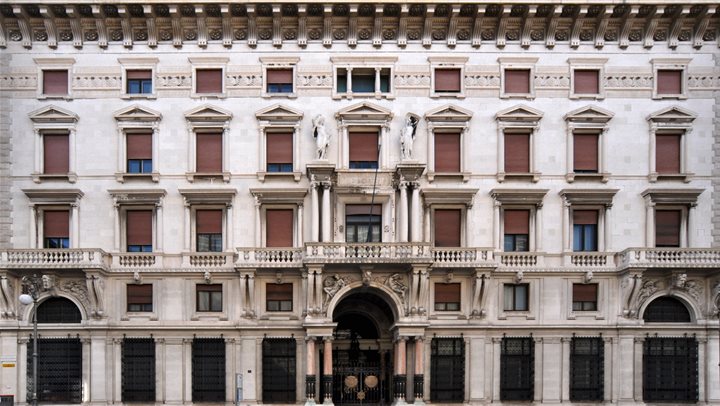RAS Palace
Built between 1911 and 1913 on the design of architects Ruggero and Arduino Berlam by the Bonetti & Co. Company of Trieste, this building was to house the new headquarters of the "Riunione Adriatica di Sicurtà "(RAS), established in 1838, "with adequate force to the needs of that time and developed during the following years with a crescendo that led it to the top in the field of insurance companies at national level."
The reports of that time narrate that "the city had not known such an impressive architectural creation yet."
The building was built with the most sought-after materials of that time with cutting-edge rational criteria and was located in an area carefully selected by Adolfo Frigessi, the Director-General of the RAS in charge at the time, in a way that the façade can be as visible as possible.
The demolition work of the pre-existent buildings brought to light important archaeological findings (a mosaic dating back to the second century A.D., the ruins of a pagan temple dedicated to the "Bona Goddess" and a headstone of the first century B.C.) preserved in the "Lapidario Tergestino".
The façade, boasting an exquisitely eclectic-style inspired by the Renaissance, has nine openings in the lower part, concealed by heavy wrought iron gratings with rich relief decorations.
The main entrance, with an arched ceiling decorated with rose windows and supported on two sides by three columns, is characterised by its majestic aspect.
The façade is decorated by two statues in Botticino polished stone by sculptor Gianni Marin representing Foresight and Protection, and other allegorical figures by sculptor Giovanni Mayer symbolizing Fire, Air, Thought, Action, Water and Earth.
The entrance leads to the wide vestibule where is the "Gladiator's Fountain" by Marin, defined by Sibilia as "the largest polychrome work existing" (Rose Candoglia marble, silvered bronze, Siena brocatelle, Vrsar stone, red Asiago marble).
The group of sculptures is composed of "three lions drinking, stopped by a naked gladiator wearing a precious-metal helmet. Classical echoes are reflected in the volumetric plasticity of the energetic male figure and in the vital force of the wild beasts" (symbol of the human intellect that controls the forces of nature).
From the vestibule, whose floor reproduces the pattern of the Roman mosaic of the second century A.D., you can access the staircase of honour and the upper floors where the "Management Hall" and the "Meeting Room" stand out.
Special attention deserves the office furniture, an example of the standardised office furniture inspired by American models, and the furniture of the "President's Office", in the style of "domestic gemuetlichkeit".






